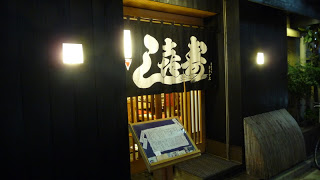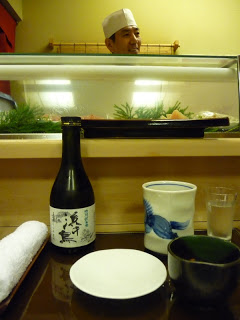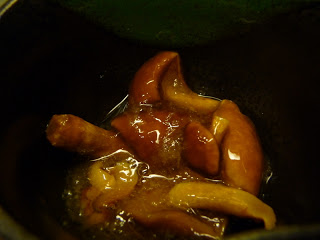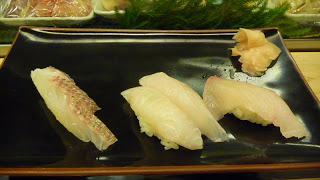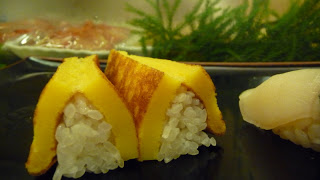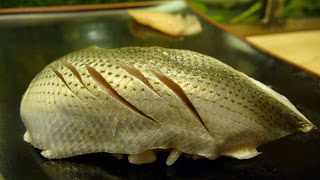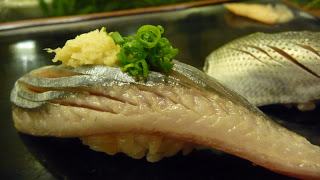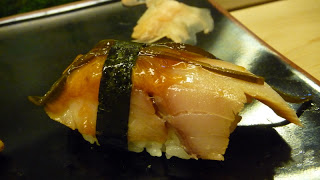Here’s the ‘setup’ to start eating. Another funny coincidence – this sake (and by extension, or perhaps more causally, the head waitress / wife) were from a town in Iwate called Kamaishi. I learned that first character, kama 釜, by being on a road trip in Iwate (out to Japan’s easternmost point, Jodogahama) and seeing signs for the next big town down the coast – Kamaishi. I think it’s an elegant character, and it’s a bonus that it’s food-related (those iron pots with wooden lids that you can use to boil rice – ‘kamameshi’, if you like).
Continuing to challenge yourself is good, because you can continue to surprise yourself. Usually I’d say I don’t like nameko, because it seems wrong for mushrooms to be slimy, and I don’t like slimy things, never have. But these big nameko were delicious. I would have eaten more of them. People should put these in soup instead of the little ones that don’t taste as good and are all slimy to boot.
It’s a mistake to go any place expecting perfection. Your best bet is to have a nice dinner and wait to be amazed once in a while. Tonight, I was amazed by the sanma – a humble fish, but one that illustrates the old saw that a perfect sanma is always better than a crappy toro. But first I started as I often do, by asking for a selection of white fish. Hmmm, I’m pretty sure that these were madai, ishidai and hirame from left to right, but it would be silly of me to remember that, wouldn’t it? I do remember that the madai, which was definitely the piece on the left, was esselente. That’s Spanish. I’m bringing a little fusion element to it.
Since I knew I wouldn’t be taking any pictures of the vastly more expensive sushi the next night, I took too many here. Their egg runs to thin-and-sweet, which isn’t entirely my preference. You could certainly treat this as a dessert if you were so inclined. The chef also gave me a little experimental piece later where he had been soaking the sheets of egg in some kind of sauce made with shrimp paste. It was even sweeter, and fortunately he said out loud the thing that we were both thinking about how it wasn’t really that good.
A nice piece of kohada. If left to my own devices, I’ll follow a pattern at sushi – courses of white fish, shellfish, and silver fish, with maybe some tuna or fish eggs at the end. Omelet, for some reason, goes with shellfish in my mind, so I order it in that position (did you see the edge of a scallop in the above picture). It’s like the rhythm of izakaya ordering – I’ll always start with cold fish and vegetables, then work through grilled and into fried. It bugs me when people get all excited and order deep-fried stuff in the first round. Not enough that I’d say anything, but now that I’ve written it I’m sure I’ll hear about at a dinner soon…
Also a nice piece of horse mackerel. This puts me in mind of one time when we ordered takeout sushi somewhere out in Yamanashi (probably the anniversary of the death of one relative or another; that’s always a good excuse for a party). The nigiri looked kinda like this, but were twice the size. You just couldn’t eat them. It was gross. Those country people, what do they know about sushi? Stick with the hoto and preserved abalone, guys.
And I’ve saved the best for last, a creative bit. This is terrific sanma, which is right in the best season now, that’s been a little pickled in plum-based sauce and seaweed. Cool. I sorta wish he had a whole range of funny stuff like this, but he didn’t – that’s why I got that experimental egg slice, it was all he had to offer.
[Feb 2011: Well, it turns out it’s actually mackerel in persimmon sauce. But this place is as good as I thought, maybe better the second time.]
Mission accomplished, I’d say. There just aren’t enough meals in a life to go back to all the neighborhood places I’d like to become a regular at. You probably have a place this good in your neighborhood…no, I don’t mean that. You’d be lucky to have a local this good, just like you’d be lucky to live somewhere as cool as Monzen Nakacho.
